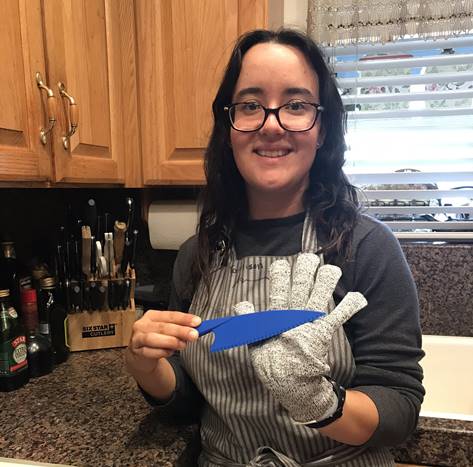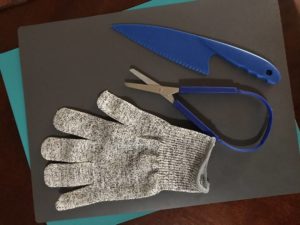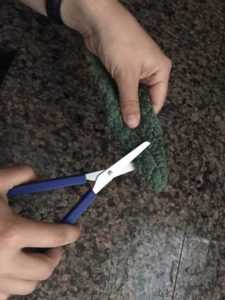Preparing Fresh Produce
February 10, 2021

As the Garden and Cooking Class Teacher at Sunflower Hill, I’m privileged to work in our beautiful Garden with an abundant amount of produce. I feel fortunate to share cooking and gardening techniques with so many program participants who are eager to learn. I love being able to showcase the garden’s fresh fruits and vegetables when teaching and appreciate the willingness of participants to learn about and try new foods. I smile when I see someone trying something new in class and enjoying what they’ve tasted!
One of the goals of my virtual Cooking Classes is to demystify preparing and eating fresh produce and other healthy foods. I want participants to know that fresh produce is both good for you AND tasty! Another goal I have for my participants is to get more comfortable in the kitchen and learn new skills. Preparing your own produce provides many opportunities to do this!
Last week, in preparation for my first cooking class of the year, I began by taking a quick inventory of my kitchen supplies. Recipes that use fresh produce are always a class favorite, so I was pretty excited about sharing how to make a nutritious smoothie. Fruits and vegetables, or produce, are delicious and an essential component to a healthy diet. Ensuring that I had the right tools to turn my fresh, delicious ingredients into a mouth-watering vanilla blueberry smoothie was the first step in making sure my kitchen was ready for tasty success.
Prepping Your Kitchen for Tasty Success
 There are some advantages to preparing and learning to cut your own produce. Fruits and vegetables in their natural form stay fresh longer than produce that is already cut or packaged in plastic. This means fewer trips to the store and fresh flavor for longer periods of time! It’s also cheaper to prepare your own produce because the packaged fruits and veggies are usually more expensive. Another bonus is that when you buy produce without packaging, you’re also helping the Earth because there’s no excess plastic containers to go in the landfill! Preparing your own fruits and veggies can be fun and a great opportunity to get more comfortable in the kitchen and learn new skills.
There are some advantages to preparing and learning to cut your own produce. Fruits and vegetables in their natural form stay fresh longer than produce that is already cut or packaged in plastic. This means fewer trips to the store and fresh flavor for longer periods of time! It’s also cheaper to prepare your own produce because the packaged fruits and veggies are usually more expensive. Another bonus is that when you buy produce without packaging, you’re also helping the Earth because there’s no excess plastic containers to go in the landfill! Preparing your own fruits and veggies can be fun and a great opportunity to get more comfortable in the kitchen and learn new skills.
Sometimes preparing your own produce is not an option. Some produce can be tricky or challenging to cut, especially when you’re learning. I remember the first time I tried to cut watermelon using a knife that was way too small. It was very frustrating and I made a big mess! I quickly realized that without the correct kitchen tool, preparing my own produce was very difficult! Also, some people may not feel comfortable or safe preparing produce on their own, or they may have a physical disability that prohibits them from doing so. That’s okay! Pre-cut fruits and vegetables are still a great, healthy option! At the end of the day, what’s most important is that you’re adding fresh fruits and veggies to your diet!
Kitchen Tool Suggestions
What tools do you need? If you’re interested in safely preparing your own produce, here are a few of my favorite tools and prepping tricks to make it easier:
- A plastic safety knife, like this one or this one is a great tool to try! The serrated plastic blade can cut through most fruits and vegetables, but is much safer near your hands than a sharp, metal blade. There are many brands out there with different grips and sizes to fit different individual needs. I’ve found success cutting fruits like strawberries, bananas, apples, and vegetables like cucumbers, lettuce, kale, and tomatoes with a plastic safety knife. (Keep an eye out for my March Adaptive Cooking Tips blog post: Safe Knife Skills).
- Purchasing a cut-resistant safety glove is another tool you might consider. Using this type of glove is an excellent way to add a layer of protection when using a metal knife or a plastic safety knife. You only need one glove to be used on the hand holding the produce, which is near the knife blade when cutting.
- Kitchen Scissors can be used to easily trim vegetable ends and snip herbs and leafy greens rather than using a knife. Adaptive kitchen scissors like loop scissors, are great for people with disabilities that might make the use of conventional scissors difficult or uncomfortable.
- Adaptive cutting boards like this one or this one hold food in place so you can easily cut with one hand.
- One of the best kitchen tools is your hands! Tear up chunks of bananas and other fruit for a fruit salad or smoothie; rip leafy greens into small, bite-sized pieces for salad; tear up herbs for a tasty garnish or sprinkle in a sauce – the options are endless! It might not be the prettiest way to prepare produce, but it gets the job done! Just don’t forget to wash your hands before and after you prepare a fruit or veggie with your hands.
Get Started Today!
 If you want to include some fruits and veggies into your diet today, you can get started using your hands! Try washing some blueberries or blackberries, peel and section an orange, or break off a section of banana for an easy, delicious, and healthy snack!
If you want to include some fruits and veggies into your diet today, you can get started using your hands! Try washing some blueberries or blackberries, peel and section an orange, or break off a section of banana for an easy, delicious, and healthy snack!
I hope this gets you inspired to begin preparing your own tasty, fresh produce! Keep an eye out for my March Adaptive Cooking Tips blog article: Safe Knife Skills, where I’ll provide tips and tricks on how to safely cut with a knife.
Story by: Abby Lourenco, Garden and Cooking Class Teacher
Contributing Writer: Karen Dito, Sunflower Hill External Communications Committee member